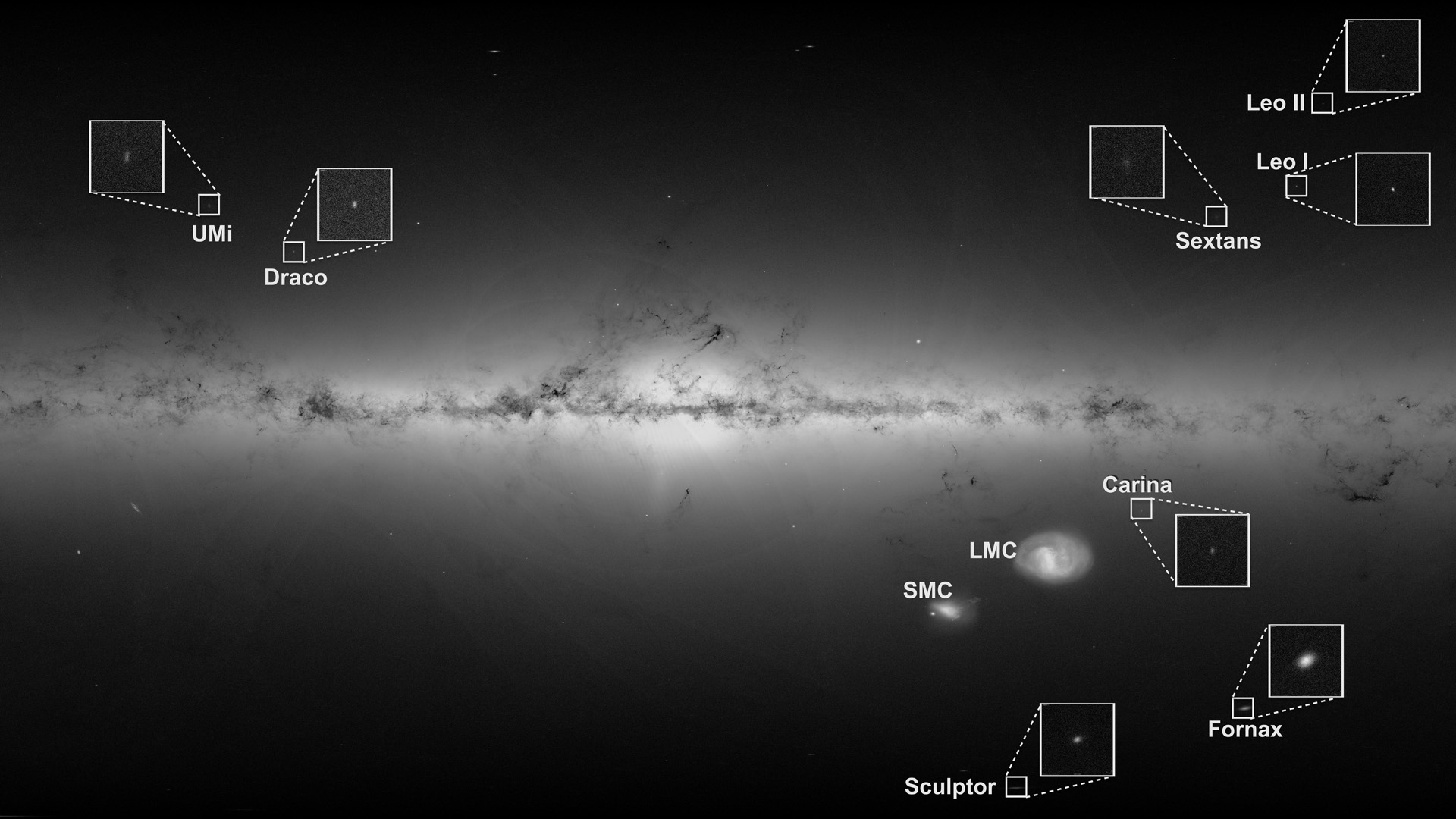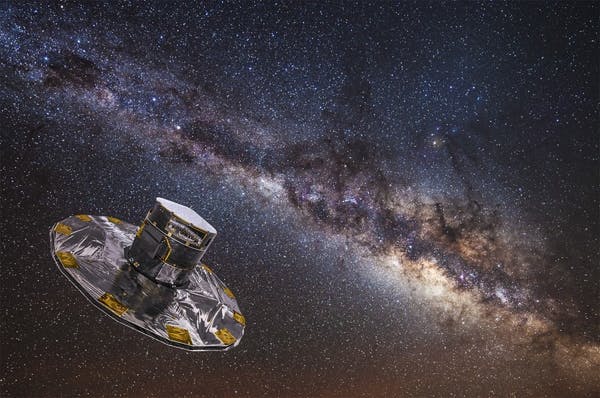The European Space Agency’s Gaia mission will release new data on June 13, and scientists can’t wait.
The coming data dump will contain information about nearly two billion of the brightest objects in the sky. The release will supercharge the mapping of our Milky Way galaxy, experts say, allowing astronomers to see to the farthest fringes of the galaxy and also distinguish much finer details in its structure than ever before.
Gaia has been mapping our stellar neighborhood since 2014, and each of its data releases have led to giant leaps in our understanding of the Milky Way. Astronomers have learned about the precise positions of vast numbers of stars, their distances from Earth and the speeds at which they travel.
Thanks to Gaia’s years of dutiful scanning of the sky, information about the stars’ trajectories and motions in three-dimensional space is getting more and more precise. Gradually, finer details of the structure of the galaxy arise in front of astronomers’ eyes, and the story of its evolution comes to life.
The upcoming release will add some previously unavailable information, including about the chemical compositions, ages and masses of millions of stars.
Related: 4 big Milky Way mysteries the next Gaia mission data dump may solve
Finer details
Among the astronomers eagerly awaiting the June 13 release is Eduardo Balbinot, a postdoctoral researcher in astrophysics at the University of Groningen in the Netherlands. Balbinot is interested in globular clusters, groupings of stars that are the “smallest building blocks of galaxies.”
Many globular clusters merged with the Milky Way billions of years ago after being drawn into its orbit by the galaxy’s gravitational pull. But even today, astronomers can distinguish their remnants among the stars.
“Globular clusters are special because they get torn apart [when they fall into the galaxy], but they still live as coherent groups of stars in the sky as stellar streams,” Balbinot told Space.com. “So the first thing I am going to do after I finish downloading this gigantic data set is to look for these dissolved streams of stars.”
Balbinot is particularly looking forward to digging into a large set of measurements of radial velocities, the motion of stars away or toward the observer. To obtain these measurements is not an easy feat, because stars tend to be so far away that the difference measured by Gaia over mere years of human time is barely perceptible. Still, the telescope, accompanying Earth in its orbit around the sun in the Lagrange Point 2 (the same region where the James Webb Space Telescope sits), is getting better at the task. It is from these radial velocities that Balbinot and his colleagues hope to reconstruct the finer structure of the Milky Way.
“The sample of radial velocities will be larger by a factor of 10 than what has been available before,” Balbinot said. “And that’s really exciting. You can find these groups of stars that move similarly and basically reconstruct where they came from.”
A living map
Gaia data allows astronomers to do more than just map the Milky Way as it is today. Since objects in space follow the rules of physics, the data enables them to model the trajectories of stars millions, or even billions of years into the past and future. The result is a three-dimensional movie of the galaxy’s evolution that is getting increasingly finer and more precise, and that stretches farther into the past.
The new data release will inject some color into this map as it contains information about astrophysical parameters for nearly half a billion stars. Astrophysical parameters, derived from the stars’ light spectra (essentially fingerprints of how stars absorb light), reveal information about the stars’ masses, ages, temperatures and brightness levels.
For two million stars, Gaia also measured chemical compositions of stellar atmospheres, which reflect the compositions of the molecular clouds in which these stars were born billions of years ago.
By combining the information about chemical compositions with the stars’ trajectories reconstructed from Gaia’s measurements, astronomers can track stars to their birth places. They can not only identify in which part of the Milky Way each group of stars formed, but also pick out those that arrived from elsewhere. (The Milky Way as we see it today came into being from collisions with other, smaller galaxies. Stars that came from these other galaxies have a unique chemical fingerprint.)
“One of the exciting things that you can do with Gaia is that you can find these groups of stars that move similarly and basically reconstruct from where they came from, and which building block brought them into our Milky Way,” said Balbinot. “Ultimately, [you can] answer the question of how the Milky Way was formed.”

The elusive spiral structure
Two billion stars may seem like a lot, but in fact, it’s just about 1% of the expected number of stars in the Milky Way galaxy. Thanks to sophisticated algorithms and a lot of scientific knowledge, astronomers can extrapolate what they learn from Gaia to better understand the galaxy as a whole. One of the outstanding questions they hope to learn more about is the Milky Way’s trademark spiral structure.
Astronomers mostly agree that the Milky Way has four spiral arms, the dense twisting streams of stars and gas that appear to emanate from the galaxy’s center. But there are quite a few points of contention around these spiral arms. Astronomers still debate the size and prominence of the individual arms, as well as their exact position in the Milky Way’s disk. The new data might help reveal the spiral structure with better clarity.
“With the astrophysical parameters that we now have, we can directly create samples of stars for specific science cases,” Jos de Bruijne, Gaia project scientist at the European Space Agency, told Space.com. “We know that the spiral arms are mostly made of young stars. It’s where stars form. So with the new data, we can look, for instance, at stars that are no older than 100 million years.” (100 million years is infancy in stellar terms. Our own sun is 4.6 billion years old and still has five billion years to go.)

Seeing farther
Balbinot said that the new data set will reveal information about stars much farther away from Earth than those in Gaia’s previous releases. Some of these stars are on the very edge of the Milky Way, where the so-called galactic halo, the diffuse sphere of thinly scattered stars surrounding the galaxy’s much more massive disk, meets intergalactic space.
“These are variable stars, very bright stars that vary in brightness over time,” said Balbinot. “Because of their brightness, we can detect them even very far away. Some of those stars are on the very edge of the Milky Way, and that’s very exciting because this really is an unchartered territory. Everything that we’ll find there will be new and exciting.”
In these far away reaches of the galaxy, Balbinot hopes to find evidence of more ancient galactic collisions and distinguish structures that emerged from them.
“These collisions leave various types of debris behind,” he said. “Sometimes it’s the stellar streams, but sometimes it can create shells, spherical features in the Milky Way’s halo. I think that with these variable stars, we might be able to pick up some of these shells in the outer halo. And that would help us to reconstruct in detail how these collisions happened.”
Follow Tereza Pultarova on Twitter @TerezaPultarova. Follow us on Twitter @Spacedotcom and on Facebook.

